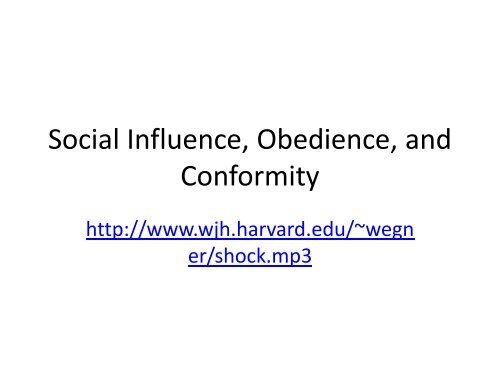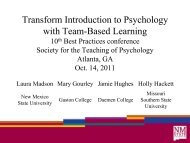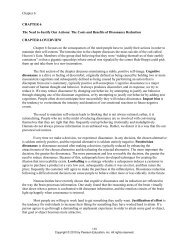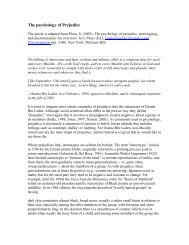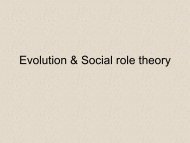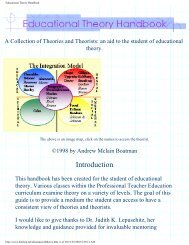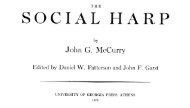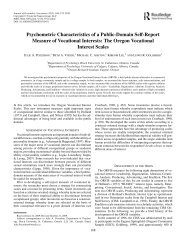Social Influence, Obedience, and Conformity
Social Influence, Obedience, and Conformity
Social Influence, Obedience, and Conformity
Create successful ePaper yourself
Turn your PDF publications into a flip-book with our unique Google optimized e-Paper software.
<strong>Social</strong> <strong>Influence</strong>, <strong>Obedience</strong>, <strong>and</strong><br />
<strong>Conformity</strong><br />
http://www.wjh.harvard.edu/~wegn<br />
er/shock.mp3
<strong>Conformity</strong><br />
• A change in one’s behavior due to the real or<br />
imagined influence of other people.<br />
• What factors influence conformity?<br />
– Ambiguity: use other’s behavior as a cue<br />
– Fear of ridicule, punishment or rejection
<strong>Social</strong> <strong>Influence</strong><br />
• Informational social influence<br />
– Looking to others as a guide for behavior<br />
– Others are used as a source of information<br />
• Normative social influence<br />
– Shared rules for behavior<br />
– Conform to be liked <strong>and</strong> accepted by others
Information <strong>Social</strong> <strong>Influence</strong><br />
• Uncertain, ambiguous situations when norms<br />
are not known<br />
– Light Movement<br />
– Energy Consumption<br />
– Towel Re-use<br />
– Binge Drinking<br />
• <strong>Influence</strong> behavior by reducing ambiguity with<br />
regard to norms
Sherif (1936):<br />
Autokinetic Effect
Public compliance vs. Private<br />
• Private acceptance:<br />
• Public compliance:<br />
Acceptance<br />
• Did people really believe the light was moving?<br />
– Sherif cast doubt on public compliance explanation by<br />
asking people to judge the lights again when alone. They<br />
continued to give the group’s answer.<br />
– Suggest that people were relying on each other to define<br />
reality
Factors that increase informational<br />
• Ambiguity<br />
social influence?<br />
• When it is a crisis situation<br />
• When there are experts<br />
• When accuracy is important
When informational social influence<br />
• War of the worlds<br />
backfires: PANIC<br />
– http://www.youtube.com/watch?v=QUBisKB5l98&feature=related
When informational social influence<br />
backfires: CONTAGION <strong>and</strong> ILLNESS<br />
• Bird flu<br />
• Dancing<br />
Plague<br />
of 1518<br />
• Gaseous<br />
Fumes<br />
• Dance<br />
party<br />
http://scienceblogs.com/cortex/2009/06/social_contagions.php
Resisting Informational <strong>Social</strong><br />
<strong>Influence</strong><br />
Ask Yourself:<br />
• Do other people know any more about what is<br />
going on than I do?<br />
• Is an expert h<strong>and</strong>y who should know more?<br />
• Do the actions of other people or experts seem<br />
sensible?<br />
• If I behave the way they do, will it go against my<br />
common sense or against my internal moral<br />
compass, my sense of right <strong>and</strong> wrong?
Normative <strong>Social</strong> <strong>Influence</strong><br />
• <strong>Social</strong> Norms: rules a group has for the<br />
acceptable behaviors, values, <strong>and</strong> beliefs of its<br />
members<br />
• Expectations about how group members should<br />
behave<br />
• Members who do not conform are perceived as<br />
different, difficult, <strong>and</strong> eventually deviant<br />
• Deviant members can be ridiculed, punished, or even<br />
rejected by other group members<br />
• Norms for dating, class, in the dorm, State fans,<br />
republicans…..
Normative <strong>Social</strong> <strong>Influence</strong><br />
• Asch’ research<br />
– P’s seated with two confederates. Asked to<br />
estimate which lines were of approximately equal<br />
length
Asch’s Research<br />
• 76% went along with group answers at least once<br />
• <strong>Conformity</strong> decreased when …..??
Question<br />
• Was Solomon Asch’s line experiment a true<br />
experiment?
Promoting beneficial behavior<br />
• Injunctive norms (prescriptive norms):<br />
promise rewards or punishment for behavior<br />
– What people “should” do<br />
• Descriptive norms: inform people about<br />
effective behavior<br />
– What people typically do<br />
http://www.youtube.com/watch?v=Zf_PE1Ivj4k
Influencing Behavior<br />
• Norms influence behavior to the extent that<br />
they are salient, personally relevant, <strong>and</strong>/or<br />
personally important<br />
– Descriptive norm:<br />
• People typically eat fruits <strong>and</strong> vegetables daily<br />
• People typically recycle soda bottles<br />
– Injunctive/Prescriptive norm:<br />
• Women should not sleep around<br />
• You should not throw trash on the ground
Shultz et al., 2007: Energy<br />
consumption<br />
• People divided into 2 groups: below average<br />
consumer/above average consumers<br />
• R<strong>and</strong>om assignment<br />
– Descriptive norm: how much they used, average<br />
use, + tips on conservation<br />
– Descriptive norm plus injunctive norm condition:<br />
all of the above + / <br />
• Boomerang effect vs. success
Energy Consumption<br />
• What other factors in the descriptive norm +<br />
injunctive norm condition might have lead to<br />
its success?
Resisting <strong>Social</strong> Norms<br />
Resisting <strong>and</strong> rejection<br />
Some norm violations are acceptable when<br />
loyalty to group<br />
inside allies<br />
lack cohesiveness<br />
Idiosyncrasy credits
Normative social influence exerts<br />
more influence when….<br />
<strong>Social</strong> Impact Theory<br />
• The strength of the group’s importance, the<br />
groups cohesiveness<br />
• Powerful when we like or admire those in the group<br />
• Its immediacy (proximity in time <strong>and</strong> space)<br />
• The number of people
Select the scenario that is most likely<br />
to result in conformity using social<br />
impact theory.<br />
a) Two best friends telling you to come to a party even<br />
though you have a paper due tomorrow<br />
b) Potential long term romantic partner suggesting you<br />
have sex without a condom<br />
c) A large group of Taiwanese school children coercing<br />
three other children to smoke cigarettes<br />
d) Six school children are bullying a loner child, they<br />
want a 7 th child to join in the taunting<br />
e) Your entire family want you <strong>and</strong> your husb<strong>and</strong> to have<br />
a baby.
<strong>Conformity</strong> Application<br />
• Brainstorm behaviors in which there may be<br />
some ambiguity with regard to social norms<br />
– Eating <strong>and</strong> Dieting<br />
– Depression or anxiety—rumination <strong>and</strong><br />
counterfactual thinking<br />
– Exercising<br />
– <strong>Social</strong> phobia/social skills<br />
– Bullying<br />
• Let’s vote: Which behavior should we use?
Using <strong>Social</strong> <strong>Influence</strong> to Promote<br />
Beneficial Behavior<br />
• Imagine that you are in a position to (therapist, doctor,<br />
school counselor) help people develop healthy<br />
behaviors (or change their maladaptive behaviors).<br />
• Develop a method to reduce ambiguity <strong>and</strong> change<br />
behavior.<br />
– (Hint: think about Schultz et al., 2007 energy consumption<br />
study)<br />
• Think about how motivation to be accurate or to get<br />
along might influence behavior change.<br />
• I’ll give you 15 minutes in teams, then we’ll discuss our<br />
ideas with the whole class.
Milgram’s <strong>Obedience</strong> Study<br />
• Participants were recruited via a newspaper ad<br />
• They were told they that the study was<br />
investigating the effects of punishment on<br />
learning<br />
• One person (confederate) was the learner<br />
• The participant was the ‘teacher’ <strong>and</strong> would read<br />
words to the learner, punishing errors by<br />
administering electric shock<br />
• The device contained thirty numbered switches<br />
ranging from 15 volts to 450 volts.
Milgram’s Study<br />
• The two persons present—the real participant<br />
<strong>and</strong> the confederate drew slips of paper from<br />
a hat to determine who would be the learner<br />
<strong>and</strong> who would be the teacher
Milgram’s Study<br />
• The drawing was rigged so that the participant<br />
was always the teacher.<br />
• The teacher was told to deliver a shock to the<br />
learner each time he made an error.<br />
Teachers were told to increase<br />
the strength of the shock<br />
each time the learner<br />
made an error.
Milgram’s Study<br />
• Using the h<strong>and</strong>out, predict what you would do<br />
<strong>and</strong> what others would do.
Milgram’s Study<br />
• __% showed total obedience—they<br />
proceeded through the entire series to the<br />
450 volt level.<br />
• __% obeyed even when they were required to<br />
force the victim’s h<strong>and</strong> down on a metal shock<br />
plate<br />
• BBC redo<br />
• http://www.youtube.com/watch?v=IzTuz0mNlwU&feature=related
Why did people not resist authority?<br />
• The experimenter was fast paced <strong>and</strong> did not<br />
give the person time to reflect<br />
• Justifying one’s behavior<br />
– Once you give the initial shock……..<br />
• Loss of personal responsibility
Do people obey in ‘real’ life?<br />
• When? Provide some examples<br />
• Under what conditions are people likely to<br />
obey?
Jonestown—People’s Temple<br />
Rw<strong>and</strong>a<br />
Sudanese Genocide<br />
Armenian Genocide
Milgram 2009<br />
• In a replication study……..do you think rates of<br />
compliance differed significantly from the<br />
original study? Why or why not?
Distinguish between the following<br />
<strong>Obedience</strong>, conformity, <strong>and</strong> social influence<br />
Think, pair, share
• Who ya gonna call?<br />
– http://improveverywhere.com/2010/05/18/whoyou-gonna-call/<br />
• Don’t jump<br />
– http://improveverywhere.com/2005/12/10/suicid<br />
e-jumper/
Questions<br />
• It has sometimes been argued that social<br />
influence is the most basic <strong>and</strong> important<br />
aspect of social behavior. Do you agree? Can<br />
you think of any forms of social behavior (e.g.,<br />
aggression or helping) in which influence does<br />
not play a role?
3 minute reflection: Under what<br />
conditions is someone most likely to<br />
conform to or obey or succumb to social<br />
influence?


